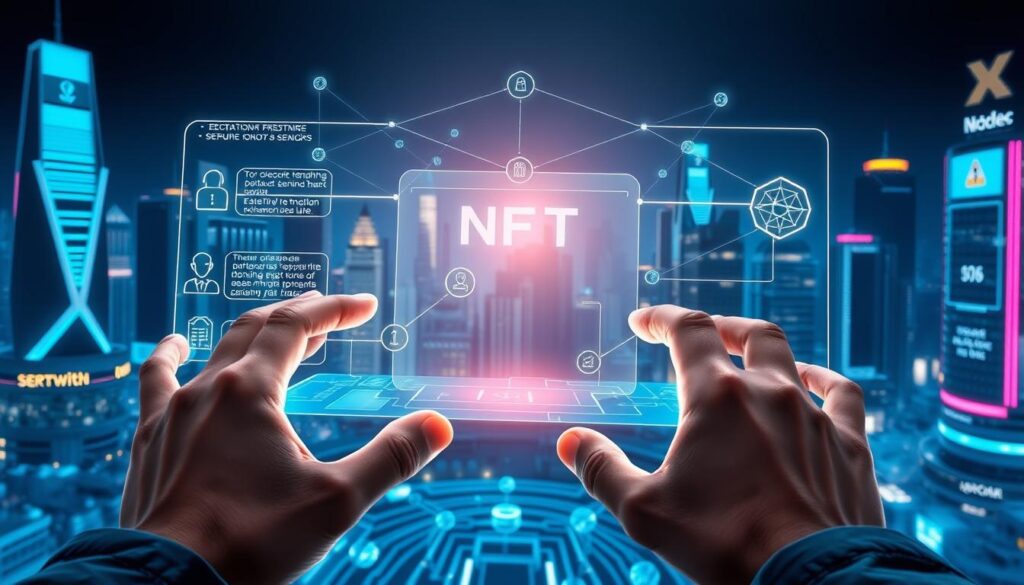Now Reading: NFT Domain Name Blockchain Registration: Secure Your NFT
- 01
NFT Domain Name Blockchain Registration: Secure Your NFT
NFT Domain Name Blockchain Registration: Secure Your NFT

The digital landscape is undergoing a profound transformation with the emergence of Web3 technologies. Traditional online identity management is being revolutionised by innovative approaches that grant users unprecedented control.
This comprehensive guide explores how blockchain technology fundamentally changes digital asset ownership. Instead of leasing web addresses from centralised authorities, individuals can now possess them outright through tokenisation.
These new digital assets function as unique tokens stored directly in cryptocurrency wallets. They offer complete autonomy and permanent ownership records that cannot be altered or revoked.
The applications extend far beyond conventional website hosting. These versatile assets serve as simplified cryptocurrency payment addresses and secure login credentials for decentralised applications.
This technology represents a practical solution for anyone seeking censorship-resistant online presence. It streamlines cryptocurrency transactions while providing robust security features that protect digital identities.
Key Takeaways
- Blockchain technology revolutionises traditional web address management
- Users gain complete ownership rather than temporary leasing arrangements
- Digital assets become unique tokens stored in personal cryptocurrency wallets
- Applications include payment addresses and decentralised application access
- The system offers enhanced security and censorship resistance
- Ownership records remain permanent and cannot be altered
Understanding NFT domain name blockchain registration
A new era of internet identity management is emerging with decentralised solutions. These innovative approaches give users unprecedented control over their digital presence.
What Are NFT Domains?
Non-fungible token web addresses represent a fundamental shift from conventional online naming systems. Unlike traditional domain names that rely on centralised servers, these digital assets store ownership information directly on distributed networks.
Each unique web address functions as a distinct digital certificate of ownership. The technology ensures that no two addresses are identical, providing true digital property rights.
These innovative web addresses come with distinctive endings like .crypto, .nft, and .wallet. They are managed by Web3 providers rather than traditional internet authorities.
The Role of Blockchain in Securing Domains
Blockchain technology provides the foundation for unprecedented security in digital asset management. The decentralised nature of this system eliminates single points of failure.
Ownership records become permanent and tamper-proof through distributed ledger technology. No central authority can alter or revoke ownership without the holder’s permission.
This approach offers robust protection against censorship and unauthorised modifications. Users maintain complete control through private keys stored in their digital wallets.
Fundamentals of NFT Domains and Blockchain Technology
A fundamental shift in how we perceive online ownership is occurring through distributed ledger technology. This transformation redefines the very essence of digital property rights and verification processes.

Differences Between Traditional and NFT Domains
Conventional web addresses operate through centralised registrars and hierarchical systems. Users essentially lease these assets with annual renewal requirements.
In contrast, decentralised alternatives provide permanent ownership stored directly in digital wallets. The verification process moves from central authorities to distributed networks.
This creates true digital property rights that cannot be revoked or suspended by any single organisation.
Decentralisation and Smart Contracts
Smart contracts automate ownership transfers and payment processing without intermediaries. These self-executing agreements ensure transparent and immutable transaction records.
The decentralised approach offers significant resistance to censorship and server failures. Users maintain complete autonomy over their digital assets and configurations.
This technology represents a practical evolution in how we manage online identities and transactions.
How to Register and Secure Your NFT Domain
Acquiring a digital asset on the blockchain involves selecting a trusted platform and following a straightforward process. This guide outlines the key steps to ensure a smooth and secure acquisition.
Choosing a Reputable NFT Domain Provider
Your first step is selecting a reliable platform. Established services like Unstoppable Domains and the Ethereum Name Service are popular choices.
These platforms offer distinct extensions and features. It is crucial to compare their supported networks and fee structures before committing.
Look for providers with a strong track record and positive community feedback. This due diligence helps protect your investment.

Step-by-Step Domain Registration Process
Begin by searching for your desired web address on the provider’s site. The platform will show availability and the cost, which can vary significantly.
Next, you must connect a compatible cryptocurrency wallet. This digital wallet is essential for both payment and storing your new asset.
After confirming the transaction, the asset is minted and transferred to your wallet. You then have complete control through your private keys, with no need for annual renewals.
Integrating Crypto and Web3 for Enhanced Domain Utility
Practical utility transforms digital assets from mere collectibles into functional tools for the modern internet. These Web3 properties bridge the gap between complex cryptocurrency systems and user-friendly experiences.

Linking Your Crypto Wallet to Your Domain
Connecting your digital wallet to a Web3 asset creates a powerful payment solution. Instead of sharing lengthy alphanumeric addresses, users can receive payments at memorable locations like “username.eth”.
The integration process is straightforward. Popular wallets like MetaMask or Coinbase Wallet connect through provider interfaces. This establishes a permanent link that automatically resolves payment destinations.
Utilising NFT Domains for Decentralised Applications
These assets serve as universal identifiers across the Web3 ecosystem. Users maintain a single, consistent identity across multiple platforms and services.
Over 600 integrations support this authentication method. Platforms like ENS demonstrate how traditional internet services and Web3 technology converge seamlessly.
| Feature | Traditional System | Web3 Integration |
|---|---|---|
| Payment Addresses | Complex alphanumeric strings | Human-readable names |
| User Identity | Multiple login credentials | Single universal identifier |
| Content Control | Centralised management | Complete user ownership |
| Platform Support | Limited integrations | 600+ ecosystem partners |
This functionality extends beyond basic website hosting. Content creators benefit from censorship-resistant publishing while businesses enjoy simplified cryptocurrency transactions.
Conclusion
Individual control over internet identity marks a significant departure from centralised systems. This technology empowers users with true digital ownership, moving beyond traditional leasing models.
The advantages are substantial. Owners gain permanent rights without renewal fees, particularly with services like Unstoppable Domains. They also enjoy censorship resistance and simplified crypto transactions.
Today’s market offers robust options through established providers. The .eth extension demonstrates strong integration across the expanding Web3 ecosystem.
While browser compatibility remains a consideration, the trajectory points toward growing mainstream adoption. This represents a fundamental shift in how we manage our digital presence.
FAQ
What is the primary advantage of owning a Web3 domain?
The main benefit is full, permanent ownership. Unlike traditional domains that require annual renewal fees, a Web3 domain is yours for life once purchased. This gives you complete control over your digital identity and associated content.
Can I use my Web3 domain to receive cryptocurrencies?
Absolutely. One of the key utilities is simplifying crypto transactions. You can link your Web3 domain to your wallet address, allowing others to send you various cryptocurrencies using your human-readable domain name instead of a long, complex string of characters.
How do I access websites hosted on these new domains?
To view sites on the decentralised web, you typically need a compatible browser extension or a browser that supports the technology, such as Brave. These tools resolve the domain name and display the content stored on the distributed network.
Are these domains recognised by the standard Domain Name System (DNS)?
Currently, they are not part of the conventional DNS used for .com or .co.uk addresses. They operate on their own decentralised name system, which is why special browsers or extensions are needed for access. However, some providers are working on bridging this gap.
What happens if I lose access to my crypto wallet?
Since ownership is tied to the wallet, losing access can mean losing control of your digital asset. It is crucial to securely back up your wallet’s private keys or seed phrase. This is the only way to recover and prove you are the rightful owner.
Is there a secondary market for these digital assets?
Yes, a vibrant marketplace exists. Owners can list their Web3 domains for sale on various platforms. The value is often determined by the name’s brevity, memorability, and perceived brandability, similar to the traditional domain aftermarket.











